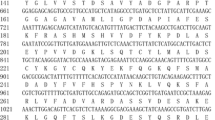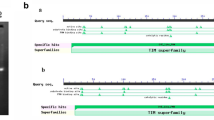Abstract
A new full-length cDNA encoding 3-hydroxy-3-methylglutoryl-Coenzyme A reductase (HMGR; EC1.1.1.34), which catalyzes the first committed step of isoprenoids biosynthesis in MVA pathway, was isolated from young leaves of Euphorbia Pekinensis Rupr. by rapid amplification of cDNA ends (RACE) for the first time. The full-length cDNA of HMGR (designated as EpHMGR, GenBank Accession NO. EF062569) was 2,200 bp containing a 1,752 bp ORF encoding 583 amino acids. Bioinformatic analyzes revealed that the deduced EpHMGR had extensive homology with other plant HMGRs and contained two transmembrane domains and a catalytic domain. The predicted 3-D model of EpHMGR had a typical spatial structure of HMGRs. Southern blot analysis indicated that at most two copies of EpHMGR gene existed in E. Pekinensis genome. Tissue expression analysis revealed that EpHMGR expressed strongly in roots, weakly in stems and leaves. The functional colour complementation assay indicated that EpHMGR could accelerate the biosynthesis of carotenoids in the Escherichia coli transformant, demonstrating that EpHMGR plays an influential role in isoprenoid biosynthesis.







Similar content being viewed by others
References
McGuire WP, Rowinsky EK, Rosenshein NB, Grumbine FC, Ettinger DS, Armstrong DK, Donehower RC (1989) Taxol: a unique antineoplastic agent with significant activity in advanced ovarian epithelial neoplasma. Ann Intern Med 111(4):273–279
Klayman DL (1985) Qinghaosu (artemisinin): an antimalarial drug from China. Science 228:1049–1055
Rohmer M, Knani M, Simonin P, Sutter B, Sahm H (1993) Isoprenoid biosynthesis in bacteria: a novel pathway for the early steps leading to isopentenyl diphosphate. Biochem J 295:517–524
Ha SH, Kim JB, Hwang YS, Lee SW (2003) Molecular characterization of three 3-hydroxy-3-methylglutaryl-CoA reductase genes including pathogen-induced Hmg2 from pepper (Capsicum annuum). Biochim Biophys Acta 1625:253–260
Laule O, Fürholz A, Chang HS, Zhu T, Wang X, Heifetz PB, Gruissem W, Lange BM (2003) Crosstalk between cytosolic and plastidial pathways of isoprenoid biosynthesis in Arabidopsis thaliana. Proc Natl Acad Sci 100:6866–6871
Chappel J (1995) Biochemistry and molecular biology of the isoprenoid biosynthesis pathway in plants. Annu Rev Plant Physio Plant Mol 46:521–547
Madureira AM, Gyémánt N, Ascenso JR, Abreu PM, Molnár J, Ferreira MJU (2006) Euphoportlandols A and B, tetracylic diterpene polyesters from Euphorbia portlandica and their anti-MDR effects in cancer cells. J Nat Prod 69:950–953
Hohmann J, Molnár J, Redei D, Evanics F, Forgo O, Szabo P (2002) Reversal of multidrug resistance of mouse lymphoma cells by a new, natural jatropane diterpenoid. J Med Chem 45:2425–2431
Ahmad VU, Hussain H, Jassbi AR, Hussain J, Bukhari IA, Yasin A, Aziz N, Choudhary MI (2003) New bioactive diterpene polyesters from Euphorbia decipiens. J Nat Prod 66:1221–1224
Mbwambo ZH, Lee SK, Mshiu EN, Pezzuto JM, Kinghorn AD (1996) Constituents from the stem wood of Euphorbia quinquecostata with qhorbol dibutyrate receptor-binding inhibitory activity. J Nat Prod 59:1051–1055
Öksüz S, Ulubelen A, Barla A, Kohlbau HJ, Voelter W (1999) Triterpenoids and a diterpene from Euphorbia iberica. Planta Med 65:475–477
Adolf W, Sorg B, Hergenhahn M, Hecker EJ (1982) Structure-activity relationship of potyfunc- tional diterpenes of the daplmane type. L Revised structure for resiniferatoxin and structure-activity relations of resiniferonol and some of its esters. Nat Prod 45:347–354
Lu ZQ, Guan SH, Li N, Chen GT, Zhang JQ, Huang HL, Liu X, Guo DA (2008) Cytotoxic diterpenoids from Euphorbia helioscopia. J Nat Prod 71:873–876
Pan DJ, Hu CQ, Chang JJ, Lee TTY, Chen YP, Hsu HY, Mcphail DR, Mcphail AT, Lee KH (1991) Kansuiphorin-C and -D, cytotoxic diterpenes from Euphorbia kansui. Phytochemistry 30:1018–1020
Duarte N, Varga A, Cherepnev G, Rádics R, Molnár J, Ferreira MJ (2007) Apoptosis induction and modulation of P-glycoprotein mediated multidrug resistance by new macrocyclic lathyrane-type diterpenoids. Bioorg Med Chem 15:546–554
Kong LY, Li Y, Wu XL, Min ZD (2002) Cytotoxic diterpenoids from Euphorbia pekinensis. Planta Med 68:813–817
Murashige T, Skoog F (1962) A revised medium for rapid growth and bioassays with bobacco tissue cultures. Physiol Plant 15:473–479
Kai G, Zhao L, Zhang L, Li Z, Guo B, Zhao D, Sun X, Miao Z, Tang K (2005) Characterization and expression profile analysis of a new cDNA encoding taxadiene synthase from Taxus media. J Biochem Mol Biol 38:668–675
Schwede T, Kopp J, Guex N, Peitsch MC (2003) SWISS-MODEL: an automated protein homology-modeling server. Nucleic Acids Res 31:3381–3385
Holtke HJ, Ankenbauer W, Muhlegger K, Rein R, Sagner G, Seibl R, Walter T (1995) The digoxigenin (DIG) system for non-radioactive labeling and detection of nucleic acids: an overview. Cell Mol Biol 41:883–905
Wang Y, Guo B, Zhang F, Yao H, Miao Z, Tang K (2007) Molecular cloning and functional analysis of the gene encoding 3-hydroxy-3-methylglutaryl coenzyme A reductase from Hazel (Corylus avellana L. Gasaway). J Biochem Mol Biol 40:861–869
Misawa N, Satomi Y, Kondo K, Yokoyama A, Kajiwara S, Saito T, Ohtani T, Miki W (1995) Structure and functional analysis of a marine bacterial carotenoid biosynthesis gene cluster and astaxanthin biosynthetic pathway proposed at the gene level. J Bacteriol 177:6575–6584
Cuningham FX, Pogson B, Sun ZR, McDonald KA, DellaPenna D, Gantt E (1996) Functional analysis of the beta and epsilon lycopene cyclase enzymes of arabidopsis reveals a mechanism for control of cyclic carotenoid formation. Plant Cell 8:1613–1626
Jiang J, Kai G, Cao X, Chen F, He D, Liu Q (2006) Molecular cloning of a HMG-CoA reductase gene from Eucommia ulmoides Oliver. Biosci Rep 26:171–181
Shen G, Pang Y, Wu W, Liao Z, Zhao L, Sun X, Tang K (2006) Cloning and characterization of a root-specific expressing gene encoding 3-hydroxy-3-methylguaryl coenzyme A reductase from Ginkgo biloba. Mol Biol Rep 33:117–127
Liao Z, Tan Q, Chai Y, Zuo K, Chen M, Gong Y, Wang P, Pi Y, Tang F, Sun XF, Tang KX (2004) Cloning and chracterisation of the gene encoding HMG-CoA reductase from Taxus media and its functional identification in yeast. Funct Plant Biol 31:73–81
Geourjon C, Deléage G (1995) ANTHEPROT 2.0: a three-dimensional module fully coupled with protein sequence analysis methods. J Mol Graph 13:209–212
Guex N, Peitisch MC (1997) SWISS-MODEL and the swiss-PdbViewer: an environment for comparative protein modeling. Electrophoresis 18:2704–2723
Istvan ES, Palnitkar M, Buchanan SK, Deisenhofer J (2000) Crystal structure of the catalytic portion of human HMGCoA reductase: insights into regulation of activity and catalysis. EMBO J 19:819–830
Enjuto M, Balcells L, Campos N, Caelles C, Arro M, Boronat A (1994) Arabidopsis thaliana contains two differentially expressed 3-hydroxy-3-methylglutaryl-CoA reductase genes, which encode microsomal forms of the enzyme. Proc Natl Acad Sci 91:927–931
Chye ML, Tan CT, Chua NH (1992) Three genes encode 3-hydroxy-3- methylglutaryl coenzyme A reductase in Hevea brasiliensis: hmg1 and hmg3 are differentially expressed. Plant Mol Biol 19:473–484
Korth KL, Stemer BA, Bhattacharyya MK, Dixon RA (1997) HMG-CoA reductase gene families that differentially accumulate transcripts in potato tubers are developmentally expressed in floral tissues. Plant Mol Biol 33:545–551
Denbow CJ, Lang S, Cramer CL (1996) The N-terminal domain of tomato 3-hydroxy -3-methylglutaryl coenzyme A reductase. J Biol Chem 271:9710–9715
Jain AK, Vincent RM, Nessler CL (2000) Molecular characterization of a hydroxymet- hylglutaryl-CoA reductase gene from mulberry (Morus alba L.). Plant Mol Biol 42:559–569
Acknowledgments
The authors are very thankful to Dr. Francis X. Cunningham (Department of Cell Biology and Molecular Genetics, University of Maryland, College Park, Maryland 20742, USA) for kindly providing plasmids. This research is financially supported by the National Natural Science Funds of China (30872028).
Author information
Authors and Affiliations
Corresponding author
Rights and permissions
About this article
Cite this article
Cao, X., Zong, Z., Ju, X. et al. Molecular cloning, characterization and function analysis of the gene encoding HMG-CoA reductase from Euphorbia Pekinensis Rupr. Mol Biol Rep 37, 1559–1567 (2010). https://doi.org/10.1007/s11033-009-9558-7
Received:
Accepted:
Published:
Issue Date:
DOI: https://doi.org/10.1007/s11033-009-9558-7




